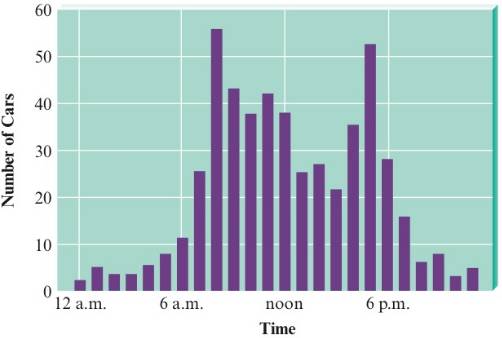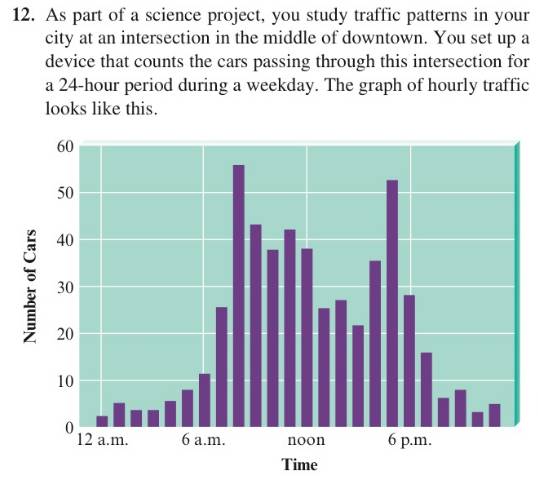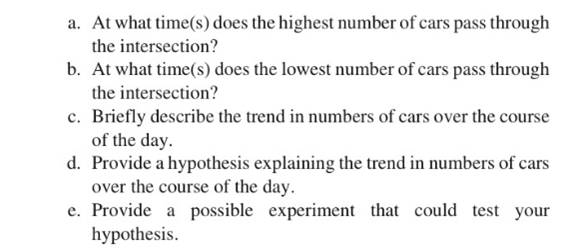
Introductory Chemistry: A Foundation
9th Edition
ISBN: 9781337399425
Author: Steven S. Zumdahl, Donald J. DeCoste
Publisher: Cengage Learning
expand_more
expand_more
format_list_bulleted
Concept explainers
Textbook Question
Chapter 1, Problem 12ALQ
As part of a science project, you study traffic patterns in your city at an intersection in the middle of downtown. You set up a device that counts the cars passing through this intersection for a 24-hour period during a weekday. The graph of hourly traffic looks like this.

- At what lime(s) does the highest number of cars pass through the intersection?
- At what time(s) does the lowest number of cars pass through the intersection?
- Briefly describe the trend in numbers of cars over the course of the day.


Expert Solution & Answer
Trending nowThis is a popular solution!

Students have asked these similar questions
A geochemist measures the concentration of salt dissolved in Lake Parsons and finds a concentration of 69.32 g.L The geochemist also measures the
concentration of salt in several nearby non-isolated lakes, and finds an average concentration of 5.02 g⋅L¯¹.
Assuming the salt concentration in Lake Parsons before it became isolated was equal to the average salt concentration in nearby non-isolated lakes, calculate
the percentage of Lake Parsons which has evaporated since it became isolated.
Be sure your answer has the correct number of significant digits.
A geochemist measures the concentration of salt dissolved in Lake Parsons and finds a concentration of 11.10 g.L-¹. The geochemist also measures the
concentration of salt in several nearby non-isolated lakes, and finds an average concentration of 4.30 g⋅L¯¹.
Assuming the salt concentration in Lake Parsons before it became isolated was equal to the average salt concentration in nearby non-isolated lakes, calculate
the percentage of Lake Parsons which has evaporated since it became isolated.
Be sure your answer has the correct number of significant digits.
A teacher developed a new chemical - NONDISTRACTUS, which allows students to focus in the classroom more and not be distracted by random events. For NONDISTRACTUS to be effective there must be a minimum concentration in the student's body of 2.00 x10-3 mol / L. If the concentration falls below this level, the students are faced with a 10 min nonproductive period where they cannot focus on anything. NONDISTRACTUS was found to undergo a very rapid first-order decay with a half-life (t½) in the bodies of students of 23 min. Based on this information:a) What is the rate law constant, k?b) If the student starts off with an initial concentration of 2.25 x 10-2 mol / L dose, how long will it be until the concentration is above the minimum 2.00 x 10-3 mol / L? Will it ensure that they are not distracted for the entire test?
Chapter 1 Solutions
Introductory Chemistry: A Foundation
Ch. 1.4 - What if everyone in the government used the...Ch. 1 - Discuss how a hypothesis can become a theory. Can...Ch. 1 - Make five qualitative and five quantitative...Ch. 1 - Prob. 3ALQCh. 1 - Differentiate between a “theory” and a “scientific...Ch. 1 - Describe three situations when you used the...Ch. 1 - Scientific models do not describe reality. They...Ch. 1 - Theories should inspire questions. Discuss a...Ch. 1 - Describe how you would set up an experiment to...Ch. 1 - If all scientists use the scientific method to try...
Ch. 1 - As stated in the text, there is no one scientific...Ch. 1 - In Section 1.3 the statement is made that it is...Ch. 1 - As part of a science project, you study traffic...Ch. 1 - Prob. 13ALQCh. 1 - Chemistry is an intimidating academic subject for...Ch. 1 - The first paragraphs in this chapter ask you if...Ch. 1 - This section presents several ways our day-to-day...Ch. 1 - The Chemistry in Focus segment titled Dr....Ch. 1 - This textbook provides a specific definition of...Ch. 1 - We use chemical reactions in our everyday lives,...Ch. 1 - Prob. 7QAPCh. 1 - Being a scientist is very much like being a...Ch. 1 - In science, what is the difference between a law...Ch. 1 - Observations may be either qualitative or...Ch. 1 - Prob. 11QAPCh. 1 - True or false? If a theory is disproven, then all...Ch. 1 - Although, in general, science has advanced our...Ch. 1 - Discuss several political, social, or personal...Ch. 1 - Although reviewing your lecture notes and reading...Ch. 1 - Why is the ability to solve problems important in...Ch. 1 - Students approaching the study of chemistry must...Ch. 1 - The ‘Chemistry in Focus” segmentChemistry: An...
Knowledge Booster
Learn more about
Need a deep-dive on the concept behind this application? Look no further. Learn more about this topic, chemistry and related others by exploring similar questions and additional content below.Similar questions
- Which of these statements are qualitative? Which are quantitative? Explain your choice in each case. (a) Sodium is a silvery-white metal. (b) Aluminum melts at 660 C. (c) Carbon makes up about 23% of the human body by mass. (d) Pure carbon occurs in different forms: graphite, diamond, and fullerenes.arrow_forwardIn an experiment, hydrochloric acid reacted with different volumes of sodium thiosulfate in water. A yellow precipitate was formed during the reaction. A cross drawn at the base of each flask became gradually invisible due the formation of this yellow precipitate. The time taken for the cross to become invisible was recorded. A partial record of the experiment is shown. Experimental Record Flask Volume of Volume of Volume of Time HCI Sodium Thiosulfate Water 1 10 mL 10 mL 40 mL 14 seconds 2 10 mL 20 mL 30 mL 3 10 mL 30 mL 20 mL 4 10 mL 40 mL 10 mL Based on your knowledge of factors that affect the rates of chemical reactions, predict the trend in the last column of the experimental record. Use complete sentences to explain the trend you predicted. You do not have to determine exact values for time; just describe the trend you would expect (increase or decrease) and why it occurs.arrow_forwardA student prepares a 1.1 mM aqueous solution of acetic acid (CH₂CO₂H). Calculate the fraction of acetic acid that is in the dissociated form in his solution. Express your answer as a percentage. You will probably find some useful data in the ALEKS Data resource. Round your answer to 2 significant digits. % x10 X ? Śarrow_forward
- In 2014 (the last year for which I can find data), Utah County had a carbon monoxide (CO) average concentration of 1.90 ppm. (1 ppm stands for 1 part per million which means in one million volumes of air—choose whatever volume unit you like—there would be one volume of carbon monoxide.) An average human takes inhales 0.50 L per breath and takes 20 breaths per minute. Carbon monoxide in the atmosphere has a density of 1.2 grams per liter. How many liters of air does a person breathe in Utah County in 8 hours? How many liters of carbon monoxide will a person breathe in Utah County in 8 hours? How many milligrams of carbon monoxide would a person in Utah County inhale in an 8 hours?arrow_forward-1 A geochemist measures the concentration of salt dissolved in Lake Parsons and finds a concentration of 4.27 g·L *. The geochemist also measures the concentration of salt in several nearby non-isolated lakes, and finds an average concentration of 2.6 g-L. Assuming the salt concentration in Lake Parsons before it became isolated was equal to the average salt concentration in nearby non-isolated lakes, calculate the percentage of Lake Parsons which has evaporated since it became isolated. Be sure your answer has the correct number of significant digits.arrow_forwardIn 2014 (the last year for which I can find data), Utah County had a carbon monoxide (CO) average concentration of 1.90 ppm. (1 ppm stands for 1 part per million which means in one million volumes of air—choose whatever volume unit you like—there would be one volume of carbon monoxide.) An average human takes inhales 0.50 L per breath and takes 20 breaths per minute. Carbon monoxide in the atmosphere has a density of 1.2 grams per liter. 3. How many milligrams of carbon monoxide would a person in Utah County inhale in an 8 hours?arrow_forward
- In 2014 (the last year for which I can find data), Utah County had a carbon monoxide (CO) average concentration of 1.90 ppm. (1 ppm stands for 1 part per million which means in one million volumes of air—choose whatever volume unit you like—there would be one volume of carbon monoxide.) An average human takes inhales 0.50 L per breath and takes 20 breaths per minute. Carbon monoxide in the atmosphere has a density of 1.2 grams per liter. 2. How many liters of carbon monoxide will a person breathe in Utah County in 8 hours?arrow_forwardThe legal limit for chromium in drinking water is 0.10 ppm. What is the maximum permissible mass of chromium (in \mu gμg) in exactly 1.0 cup (8.0 fl. oz.) of drinking water? Assume the density of drinking water is 1.00 g/mL. (1 fl. oz. = 29.57 mL)(Express your answer with two significant digits.)arrow_forwardA chemistry student must write down in her lab notebook the concentration of a solution of sodium thiosulfate. The concentration of a solution equals the mass of what's dissolved divided by the total volume of the solution. Here's how the student prepared the solution: The label on the graduated cylinder says: | empty weight: 3.550 g | She put some solid sodium thiosulfate into the graduated cylinder and weighed it. With the sodium thiosulfate added, the cylinder weighed 17.43 g. • She added water to the graduated cylinder and dissolved the sodium thiosulfate completely. Then she read the total volume of the solution from the markings on the graduated cylinder. The total volume of the solution was 61.60 mL. What concentration should the student write down in her lab notebook? Be sure your answer has the correct number of significant digits. 1 g•mLarrow_forward
- The average concentration of dissolved gold in earth's oceans is 5.8 x 10^−9 g/L. of ocean water.How many micrograms of gold are in 1.1x10^3 m^3 of ocean water? (1 ml = 1 cm3)arrow_forwardThe ocean is a heterogeneous fluid with different concentrations of zinc at different depths. Suppose that you want to know how much zinc is contained in an imaginary cylinder of ocean water that is 1 m in diameter and 2 000 m deep. How would you construct a representative sample to measure the average concentration of zinc in the cylinder?arrow_forward-1 A geochemist measures the concentration of salt dissolved in Lake Parsons and finds a concentration of 9.0 g·L The geochemist also measures the concentration of salt in several nearby non-isolated lakes, and finds an average concentration of 5.3 g·L *. Assuming the salt concentration in Lake Parsons before it became isolated was equal to the average salt concentration in nearby non-isolated lakes, calculate the percentage of Lake Parsons which has evaporated since it became isolated. Be sure your answer has the correct number of significant digits. x10arrow_forward
arrow_back_ios
SEE MORE QUESTIONS
arrow_forward_ios
Recommended textbooks for you
 Introductory Chemistry: A FoundationChemistryISBN:9781337399425Author:Steven S. Zumdahl, Donald J. DeCostePublisher:Cengage Learning
Introductory Chemistry: A FoundationChemistryISBN:9781337399425Author:Steven S. Zumdahl, Donald J. DeCostePublisher:Cengage Learning
 ChemistryChemistryISBN:9781305957404Author:Steven S. Zumdahl, Susan A. Zumdahl, Donald J. DeCostePublisher:Cengage Learning
ChemistryChemistryISBN:9781305957404Author:Steven S. Zumdahl, Susan A. Zumdahl, Donald J. DeCostePublisher:Cengage Learning Chemistry: The Molecular ScienceChemistryISBN:9781285199047Author:John W. Moore, Conrad L. StanitskiPublisher:Cengage Learning
Chemistry: The Molecular ScienceChemistryISBN:9781285199047Author:John W. Moore, Conrad L. StanitskiPublisher:Cengage Learning

Introductory Chemistry: A Foundation
Chemistry
ISBN:9781337399425
Author:Steven S. Zumdahl, Donald J. DeCoste
Publisher:Cengage Learning


Chemistry
Chemistry
ISBN:9781305957404
Author:Steven S. Zumdahl, Susan A. Zumdahl, Donald J. DeCoste
Publisher:Cengage Learning

Chemistry: The Molecular Science
Chemistry
ISBN:9781285199047
Author:John W. Moore, Conrad L. Stanitski
Publisher:Cengage Learning
Types of Matter: Elements, Compounds and Mixtures; Author: Professor Dave Explains;https://www.youtube.com/watch?v=dggHWvFJ8Xs;License: Standard YouTube License, CC-BY